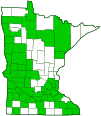Russian olive
(Elaeagnus angustifolia)
Conservation • Weed • Wetland • Description • Habitat • Ecology • Use • Distribution • Taxonomy
Description |
||
Russian olive is a moderate- to fast-growing, short-lived, deciduous, large shrub or small tree rising on a single stem. In Minnesota mature trees are usually 15′ to 20′ tall and up to 6″ in diameter at breast height, though large individuals can reach over 30′ in height. The trunk is often crooked or leaning. The crown is low, open, and rounded. The branches are erect. The bark on young trees is smooth and gray. On mature trees the bark is reddish-brown or purplish-gray. It is shallowly furrowed with orangish fissures that often spiral around the trunk. It sometimes peels in thin strips. First year twigs are densely covered with silvery scales and sometimes also with star-shaped hairs. Second-year twigs are hairless, shiny, brown to reddish-brown, and thorny. They have white pith that is finely chambered, at least below the buds. The leaf scars show a single, extended vein. The buds are small and egg-shaped with 4 overlapping scales. The leaves are deciduous, alternate, narrowly lance-shaped, 1½″ to 3″ long, and ⅜″ to ¾″ wide. They are on ⅛″ to 7 ⁄16″ long, scaly or hairy leaf stalks. The leaf blades taper to a point at the tip and are usually tapered, sometimes rounded at the base. The upper surface is dull grayish-green and may be sparsely to densely covered with silvery scales. The lower surface is densely covered with silvery scales. When young both the upper and lower surfaces are silvery white and densely covered with scales and star-shaped hairs. The margins are untoothed. The inflorescence is a cluster of 1 to 3 flowers rising from the leaf axils near the base of current-year twigs. The flowers are 5 ⁄16″ to ½″ long and perfect (have both male and female parts). The 4 sepals are fused at the base into a bell-shaped tube, then separated into 4 triangular, spreading lobes. They are yellow on the inside, and silvery on the outside. There are no petals. The flowers appear in early June to early July. The fruit is an oval, ⅜″ to ½″ long, dry, mealy drupe. It is yellowish-brown but appears silvery when young due to a dense covering of scales. The fruit ripens in mid-August to mid-September and is dispersed by birds and other animals. The pit is oblong. |
||
Height |
||
15′ to 30′ |
||
Flower Color |
||
Yellow inside, silvery outside |
||
Similar Species |
||
Autumn Olive (Elaeagnus umbellata) leaves and twigs have rusty brown, not silvery, scales. |
||
Habitat |
||
Prairies, roadsides, parks, farm shelterbelts. |
||
Ecology |
||
Flowering |
||
Early June to early July |
||
Pests and Diseases |
||
|
||
Use |
||
|
||
Distribution |
||||
|
Sources |
|||
| 6/6/2023 | ||||
Nativity |
||||
Native of Asia, eastern Europe, and the Indian subcontinent. Introduced and naturalized in North America. |
||||
Occurrence |
||||
|
||||
Taxonomy |
|||
| Kingdom | Plantae (Plants) | ||
| Subkingdom | Pteridobiotina | ||
| Phylum | Tracheophyta (Vascular Plants) | ||
| Class | Magnoliopsida (Dicots) | ||
Order |
Rosales (Roses, Elms, Figs, and Allies) | ||
Family |
Elaeagnaceae (oleaster) | ||
Genus |
Elaeagnus (oleasters) | ||
Subordinate Taxa |
|||
|
|||
Synonyms |
|||
Common Names |
|||
Oleaster Russian olive Russian silverberry Russian-olive |
|||
Glossary
Drupe
A fleshy fruit with a single hard, stone-like core, like a cherry or peach.
Pith
The spongy cells in the center of the stem.
Sepal
An outer floral leaf, usually green but sometimes colored, at the base of a flower.
Visitor Photos |
|||||
Share your photo of this plant. |
|||||
| This button not working for you? Simply email us at info@MinnesotaSeasons.com. Attach one or more photos and, if you like, a caption. |
|||||
|
|||||
MinnesotaSeasons.com Photos |
|||||
Tree |
|||||
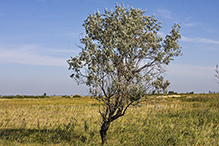 |
|||||
Bark |
|||||
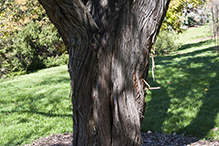 |
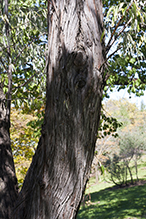 |
||||
Leaves |
|||||
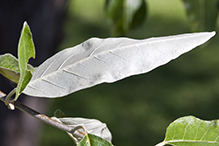 |
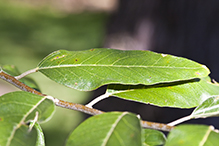 |
||||
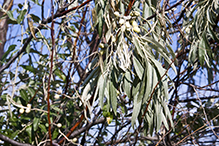 |
|||||

Slideshows |
||
| Elaeagnus angustifolia Blake C. Willson |
||

|
||
About
Russian Olive Tree |
||
| Elaeagnus angustifolia Matt Lavin |
||
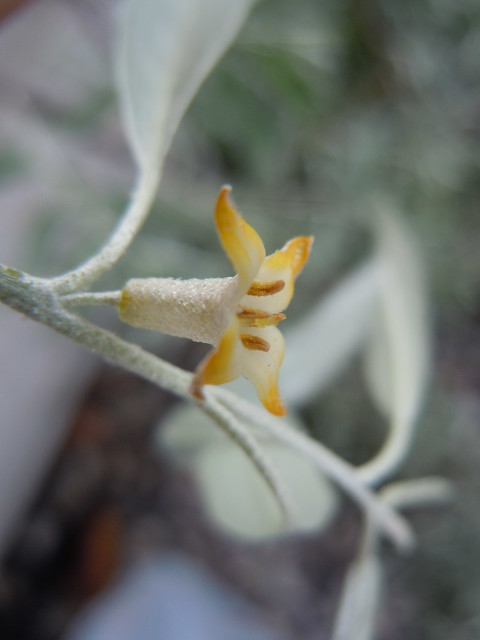
|
||
About
Introduced tree to 8 m tall, sometimes a shrub, the usually silvery twigs and narrow leaves distinguish this introduced species from the closely related native E. commutata, cultivated but often establishing in woodlands, thickets, and riparian areas in Montana especially in and around towns and agricultural areas (nutrient rich riparian areas). |
||

Visitor Videos |
|||
Share your video of this plant. |
|||
| This button not working for you? Simply email us at info@MinnesotaSeasons.com. Attach a video, a YouTube link, or a cloud storage link. |
|||
Other Videos |
|||
| How to ID Elaeagnus angustifolia Laura Deeter |
|||
About
Uploaded on Nov 19, 2008 Short video with the top identifying characteristics for Elaeagnus angustifolia |
|||
| Russian Olive - A Noxious Weed Exploring the Nature of Wyoming | UWyo Extension |
|||
About
Uploaded on Feb 17, 2009 Russian Olives are fast growing, nondescriminant, non-native trees found in Wyoming. |
|||
| Olive Russian Olive.mov Growquest |
|||
About
Uploaded on Dec 3, 2009 Olive Russian or Elaeagnus angustifolia is an excellent windbreak and wildlife tree. It is extremely tolerant of environmental factors. The best windbreak tree for high wind areas. Pictured is the Russian olive in a shrub form. Can be made into a hedge by planting 10' apart in the row. Russian olive is low in water requirements and displays a high tolerance for salt and alkali. Many russian olive plants have been planted for wild turkey and deer as a wildlife food source. |
|||

Visitor Sightings |
|||||
Report a sighting of this plant. |
|||||
| This button not working for you? Simply email us at info@MinnesotaSeasons.com. Be sure to include a location. |
|||||
|
|||||
MinnesotaSeasons.com Sightings |
|||||

|
Created: Last Updated: © MinnesotaSeasons.com. All rights reserved. |
